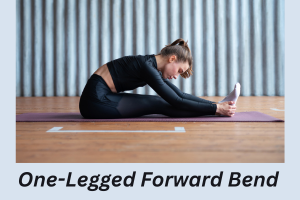Introduction
The One-Legged Forward Bend, also known as Eka Pada Uttanasana, is a challenging yet rewarding yoga pose that enhances balance, flexibility, and strength.
This pose combines the elements of a forward bend with the stabilization required to support one leg while folding the torso forward.
It not only stretches the hamstrings and calves but also engages the core muscles, promoting stability and focus.

Incorporating the One-Legged Forward Bend into your yoga practice can lead to increased mindfulness, improved concentration, and a deeper connection to your body.
It is often practiced as a preparatory pose for more advanced balancing postures, making it a valuable addition to both beginner and experienced yoga practitioners’ routines.
Steps to Perform One-Legged Forward Bend Yoga Pose/Eka Pada Uttanasana
- Begin in Mountain Pose (Tadasana): Stand tall with your feet together, grounding your weight evenly through your feet. Lengthen your spine and relax your shoulders, taking a few deep breaths.
- Shift Weight to One Leg: Slowly shift your weight onto your left leg while lifting your right leg off the ground. Engage your core to maintain balance.
- Raise the Right Leg: Inhale and extend your right leg straight out in front of you, keeping it parallel to the ground. Flex your foot and engage the quadriceps to hold the leg steady.
- Forward Bend: Exhale as you hinge at your hips, folding your torso forward over your left leg. Reach your hands towards the ground or your left foot. Keep your spine long and avoid rounding your back.
- Maintain Balance: Focus on a point in front of you to help maintain your balance. Keep your standing leg straight and strong, engaging your thigh muscles.
- Hold the Pose: Breathe deeply and hold the One-Legged Forward Bend for 5-10 breaths, feeling the stretch in your hamstrings and calves. With each inhale, lengthen your spine; with each exhale, deepen the fold.
- Return to Standing: To exit the pose, engage your core and rise back to standing, lifting your torso back up while lowering your right leg to the ground.
- Repeat on the Other Side: After a brief pause, repeat the steps on the other side, shifting your weight onto your right leg and extending your left leg forward.
Benefits of One-Legged Forward Bend Yoga Pose/Eka Pada Uttanasana
- Enhances Balance: This pose challenges your balance and coordination, helping to improve stability and proprioception.
- Stretches Hamstrings and Calves: The forward bend effectively stretches the hamstrings and calves, increasing flexibility in the lower body.
- Strengthens Core Muscles: Balancing on one leg requires core engagement, helping to strengthen abdominal and lower back muscles.
- Improves Focus and Concentration: The need to maintain balance encourages mindfulness and concentration, fostering a deeper connection to your body and breath.
- Relieves Stress: Like many yoga poses, the One-Legged Forward Bend promotes relaxation and reduces stress levels, helping to calm the mind.
- Stimulates Digestive Organs: The forward bend may stimulate digestive organs, improving digestion and relieving bloating.
- Develops Flexibility: Regular practice enhances overall flexibility, making it easier to perform other yoga poses and physical activities.
Precautions and Contraindications for One-Legged Forward Bend Yoga Pose/Eka Pada Uttanasana
- Knee Issues: Individuals with knee injuries or discomfort should practice this pose cautiously. Consider using a strap around the raised foot for support or modify the pose as necessary.
- Back Pain: Those with chronic back pain should avoid deep forward bends. It’s essential to maintain a long spine and avoid rounding the back to prevent strain.
- Balance Problems: If you have issues with balance, practice near a wall or use a chair for support until you feel more stable in the pose.
- Pregnancy: Pregnant women should consult a healthcare provider before attempting this pose, especially in later trimesters. Modifications may be needed for comfort and safety.
- Recent Surgeries: Individuals recovering from surgery or injury should seek medical advice before practicing this pose, ensuring it is safe for their condition.
- Severe Headaches or Migraines: If you are experiencing severe headaches or migraines, it’s advisable to skip this pose, as forward bends may exacerbate these symptoms.
Conclusion
- The One-Legged Forward Bend Yoga Pose is a powerful addition to any yoga practice, offering a blend of strength, flexibility, and mindfulness.
- As you work on perfecting this pose, you may notice improvements in your overall balance, focus, and physical well-being.
- Incorporating this pose into your routine can enhance your yoga journey, helping you to build a strong foundation for more advanced postures while fostering a deeper mind-body connection.
- Remember to listen to your body and practice with awareness, making necessary modifications to ensure a safe and fulfilling experience.
- Embrace the journey of mastering the One-Legged Forward Bend, and enjoy the numerous benefits it brings to your practice.
